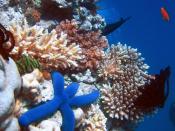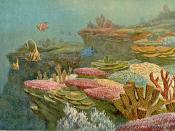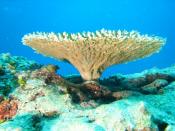Coral Reefs: Why We Must Save Them
The world's coral reefs while covering only a small portion of the ocean floor are home to approximately 25 percent of the marine animal life and they are used by many more at some point during their life cycle. Additionally thousands of marine plants live on or near coral reefs. Coral reefs are in effect cities of the seas. Humans have a huge dependency on the ocean in general and the coral reefs in particular. This paper will cover what coral reefs are, what they do for us, where the coral reefs are, what they do for us, and some of the hazards to coral reefs. So just what is coral?
Many corals look like stone formations or plants. But they are neither; they are in fact very fragile animals called coral polyps. According to Garrison, There are two types of corals; the first is Hermatypics from the Greek word hermatos meaning "mound builder," (435) which builds the reefs.
They live in the warm tropical seas. The other kinds of corals are called Ahermatypic from the Greek word ahermatos meaning "without mound builder" (436). The Ahermatypics do not build reefs; rather they build smooth banks in relatively deep water. Many species of coral have a symbiotic relationship with a type of algae called Zooxanthellae (pronounced zo-zan-THEL-ee).
Zooxanthellae are microscopic, single cell algae that live and grow with in the tissue of the hard coral polyps. Several million Zooxanthellae live in just a square inch of coral, and it is the algae the gives the corals their brownish-green hue. Zooxanthellae and coral have a symbiotic relationship and rely on each other for survival. The algae help to process the polyp's wastes, retaining important nutrients. The algae also provide the polyp with oxygen and...


